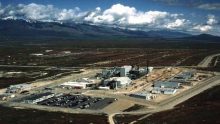Advantageous performance characteristics, declining costs and power market regulatory reform are fueling deployment of utility-scale battery-based energy storage systems (BESS), particularly to provide so-called ancillary services. Of these, frequency regulation – synchronizing AC frequencies across generation assets – is the most valuable.
South Korea’s Kokam Co. Ltd. on March 7 announced it has deployed two lithium nickel manganese cobalt oxide (LiNMC) BESS that Korea Electric Power Corp. (KEPCO) is using for grid frequency regulation. At 24MW/9MWh, one is the largest such system installed in the world to date. A second 16MW/6MWh BESS is up and running as well, while a third 16MW/5MWh lithium titanate oxide (LTO) system was deployed last August, bringing KEPCO’s installed BESS capacity to 56MW.
Kokam isn’t widely known outside industry circles, but its proprietary LiMNC battery storage technology is being used to power the world’s first megawatt-scale, fully electric submarine, the Solar Impulse long-distance PV-powered aircraft, and Deep Sea Challenger, the submersible used by James Cameron and crew to plumb the depths of the Marianas Trench, the deepest part of the world ocean.
South Korea’s Drive to Install 500MW of Battery-based Frequency Regulation Capacity
B ESS technology offers significant advantages and confers various benefits on utilities tasked with maintaining the integrity and reliability of grid power. Perhaps most significant are the ability of BESS to ramp up and down in milliseconds in response to fluctuating grid conditions.
ESS technology offers significant advantages and confers various benefits on utilities tasked with maintaining the integrity and reliability of grid power. Perhaps most significant are the ability of BESS to ramp up and down in milliseconds in response to fluctuating grid conditions.
That compares to minutes in the case of conventional fossil-fuel fired power plants. A study conducted by the Pacific Northwest National Laboratory (PNNL) suggested millisecond response times of BESS should be valued at least twice that of conventional 20-minute assets, the Energy Storage Association (ESA) highlights.
South Korea is in the midst of the world’s largest BESS frequency regulation project. The target is to install 500MW by 2017.
In addition to enhancing the efficiency of the grid, installing BESS capacity will reduce KEPCO’s need for readily available spinning reserve capacity. That, in turn, will enable the utility, South Korea’s largest, to shift generation to more efficient, lower cost power plants and reduce wear and tear across its generation fleet, Kokam highlights.
Estimated annual savings for the three Kokam BESS come in at around $13 million. Over their life, they’re expected to save three times more than the total purchase price. Also of significance, substituting BESS for fossil fuel power will reduce KEPCO’s greenhouse gas emissions.
¨Kokam specializes in the development of advanced battery technologies for the world’s most demanding energy storage system applications, including frequency regulation, which needs systems that deliver high power, fast recharge rates and long cycle lives,¨ Ike Hong, VP of Kokam’s Power Solutions Division, commented.
¨Kokam’s 56MW of energy storage systems are making a major contribution to the stabilization of our grid, and we hope to continue to cooperate with Kokam to develop energy storage projects that improve grid reliability, lower our operational costs and reduce our environmental impact,¨ added Hwang Woohyun, SVP and head of KEPCO’s Innovative Energy Business Division.
Kokam’s Ultra High Power NMC BESS Solution

Kokam has installed a total of 650 MWh of battery storage capacity in 50 countries. More than 60MWh has been installed in submarines, large ships and aircraft.
KEPCO’s two new Kokam LNMC BESS have been up and running since January. Both make use of the company’s Ultra High Power NMC battery technology, which is designed for high-power energy storage applications, such as frequency regulation, ramp rate control of large solar and wind power systems, uninterrupted power supply (UPS) and voltage support. Kokam highlights the following key attributes:
- Higher energy density: 2.4MWh energy storage capacity housed in a 40-foot container, compared to 1-1.5MWh for standard NMC batteries;
- High power cycle life: Can last up to 10,000 cycles as compared to 3,000-5,000;
- Better charge, discharge rates and max power: 4C, 8C and 15C, respectively, as compared to 2C, 3C and 4C for competing systems;
- Improved heat dissipation rate: 1.6 times better than standard NMC technologies, which translates into higher performance and longer life.
In addition, Kokam highlights the direct cooling design of its KCE 40-foot containerized Ultra High Power NMC BESS, via which HVAC only regulates temperature inside the system’s racks rather than throughout the container. That, Kokam says, reduces air conditioning auxiliary load by 70% as compared to standard containers.



